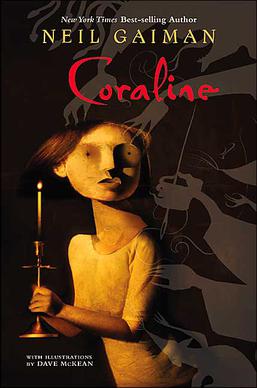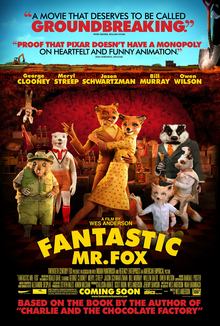
Stop motion is an animated filmmaking technique in which objects are physically manipulated in small increments between individually photographed frames so that they will appear to exhibit independent motion or change when the series of frames is played back. Any kind of object can thus be animated, but puppets with movable joints or plasticine figures are most commonly used. Puppets, models or clay figures built around an armature are used in model animation. Stop motion with live actors is often referred to as pixilation. Stop motion of flat materials such as paper, fabrics or photographs is usually called cutout animation.

Coraline is a 2002 British dark fantasy horror children's novella by British author Neil Gaiman. Gaiman started writing Coraline in 1990, and it was published in 2002 by Bloomsbury and HarperCollins. It was awarded the 2003 Hugo Award for Best Novella, the 2003 Nebula Award for Best Novel, and the 2002 Bram Stoker Award for Best Work for Young Readers. The Guardian ranked Coraline #82 in its list of 100 Best Books of the 21st Century. It was adapted as a 2009 stop-motion animated film, directed by Henry Selick under the same name.

Charles Henry Selick Jr. is an American filmmaker and clay animator, best known for directing the stop-motion animated films The Nightmare Before Christmas (1993), James and the Giant Peach (1996), Monkeybone (2001), Coraline (2009), and Wendell & Wild (2022). Selick is also known for his collaborations with the late voice actor and artist Joe Ranft.

Bruno Coulais is a French composer, most widely known for his music on film soundtracks.

Fantastic Mr. Fox is a 2009 American animated adventure-comedy film directed by Wes Anderson from a screenplay by Anderson and Noah Baumbach and based on the novel of the same name by Roald Dahl. Featuring stop-motion animation, it stars George Clooney, Meryl Streep, Jason Schwartzman, Bill Murray, Willem Dafoe, and Owen Wilson. In the film, a spree of thefts led by Mr. Fox (Clooney) results in his family, and later his community, being hunted down by three farmers.

Laika, LLC is an American stop-motion animation studio specializing in feature films, commercial content for all media, music videos, and short films. The studio is best known for its stop-motion feature films Coraline, ParaNorman, The Boxtrolls, Kubo and the Two Strings and Missing Link. It is owned by Nike co-founder Phil Knight and is located in Hillsboro, Oregon, part of the Portland metropolitan area. Knight's son, Travis Knight, acts as Laika's president and CEO.

Monsters vs. Aliens is a 2009 American animated science fiction action comedy film produced by DreamWorks Animation and distributed by Paramount Pictures. The film was directed by Conrad Vernon and Rob Letterman from a screenplay written by Letterman, Maya Forbes, Wallace Wolodarsky, and the writing team of Jonathan Aibel and Glenn Berger. Featuring the voices of Reese Witherspoon, Seth Rogen, Hugh Laurie, Will Arnett, Kiefer Sutherland, Rainn Wilson, Paul Rudd, and Stephen Colbert, the film involves a group of misfit monsters hired by the United States Armed Forces to stop the invasion of an extraterrestrial villain and save the world in exchange for freedom.

Anthony Stacchi is an American animator, effects animator, storyboard artist, screenwriter, and film director.

Ice Age: Dawn of the Dinosaurs is a 2009 American animated adventure comedy film produced by Blue Sky Studios and distributed by 20th Century Fox. It is the sequel to Ice Age: The Meltdown (2006) and the third installment in the Ice Age film series. It was directed by Carlos Saldanha and co-directed by Mike Thurmeier, from a screenplay written by Michael Berg, Peter Ackerman, Mike Reiss, and Yoni Brenner, based on a story conceived by Jason Carter Eaton. Ray Romano, John Leguizamo, Denis Leary, and Chris Wedge reprise their roles from the first two films and Seann William Scott, Josh Peck, and Queen Latifah reprise their roles from The Meltdown, with Simon Pegg joining them in the role of a weasel named Buck. The story has Manny and Ellie preparing for their baby. Sid the Sloth is kidnapped by a female Tyrannosaurus after stealing her eggs, leading the rest of the herd to rescue him in a tropical lost world inhabited by dinosaurs underneath the ice.
The 37th Annual Annie Awards, honoring the best in animation for 2009, were held on February 6, 2010, at Royce Hall in Los Angeles, California.

Travis Andrew Knight is an American animator, producer, director, actor, and former rapper who has worked as the lead animator and current CEO for the stop-motion animation studio Laika, and directed the films Kubo and the Two Strings (2016) and Bumblebee (2018). He is the son of the Nike co-founder Phil Knight.

ParaNorman is a 2012 American stop-motion animated comedy horror film directed by Sam Fell and Chris Butler, and written by Butler. Produced by Laika, the film stars the voices of Kodi Smit-McPhee, Jodelle Ferland, Bernard Hill, Tucker Albrizzi, Anna Kendrick, Casey Affleck, Christopher Mintz-Plasse, Leslie Mann, Jeff Garlin, Elaine Stritch, Tempestt Bledsoe, Alex Borstein, and John Goodman. It is the first stop-motion film to use a 3-D color printer to create character faces, and only the second to be shot in 3-D. In the film, Norman Babcock, a young boy who can communicate with ghosts, is given the task of ending a 300-year-old witch's curse on his Massachusetts town.
Moongirl is an animated short produced in 2005 by Laika. It was written and directed by Henry Selick and features a score by They Might Be Giants. It is the first film, and currently the only short film, as well as the only non-stop-motion film, produced by the company.

The Boxtrolls is a 2014 American stop-motion animated fantasy comedy film directed by Graham Annable and Anthony Stacchi loosely based on the 2005 novel Here Be Monsters! by Alan Snow. It is produced by Laika. Set in the fictional European country of Norvenia in the late-19th century, the film tells the story of Eggs, a human boy raised by trash-collecting trolls, known as "Boxtrolls", as he attempts to save them from Archibald Penelope Snatcher, a pest exterminator. This film was the animated film debut of Isaac Hempstead-Wright, who voices Eggs, the main protagonist, and features the voices of Ben Kingsley, Elle Fanning, Dee Bradley Baker, Steve Blum, Toni Collette, Jared Harris, Nick Frost, Richard Ayoade, Tracy Morgan, and Simon Pegg.

Kubo and the Two Strings is a 2016 American stop-motion animated action fantasy film produced by Laika. It is directed by Travis Knight with a screenplay by Marc Haimes and Chris Butler from a story by Shannon Tindle and Marc Haimes, and it stars the voice roles of Charlize Theron, Art Parkinson, Ralph Fiennes, George Takei, Cary-Hiroyuki Tagawa, Brenda Vaccaro, Rooney Mara, and Matthew McConaughey. Set in feudal Japan, the film revolves around Kubo, a young boy who wields a magical shamisen and whose left eye was stolen during infancy. Accompanied by an anthropomorphic snow monkey and stag beetle, he must embark on a quest to defeat his mother's evil twin sisters, Washi and Karasu, and his power-hungry grandfather, the Moon King, who is responsible for stealing his left eye.

Missing Link is a 2019 American stop-motion animated adventure comedy film written and directed by Chris Butler. The film is produced by Laika and stars the voices of Hugh Jackman, Zoe Saldana, David Walliams, Stephen Fry, Matt Lucas, Timothy Olyphant, Amrita Acharia, Ching Valdes-Aran, Emma Thompson, and Zach Galifianakis. The plot follows Mr. Link, a Sasquatch who, with the help of British explorers Sir Lionel Frost and Adelina Fortnight, travels to the Himalayas to meet his Yeti cousins.

Wendell & Wild is a 2022 American stop motion-animated horror comedy film directed by Henry Selick from a screenplay written by Selick and Jordan Peele, based on Selick's and Clay McLeod Chapman's unpublished book of the same name. It stars Keegan-Michael Key and Jordan Peele as the titular characters with Angela Bassett, Lyric Ross, James Hong, and Ving Rhames in supporting roles. This was Selick's first feature film since Coraline (2009).
A Tale Dark & Grimm is an animated television series based on the children's book of the same name by Adam Gidwitz. Developed for Netflix by Doug Langdale and Simon Otto, the series premiered on October 8, 2021. Netflix did not renew the show for a second season.

Coraline (Original Motion Picture Soundtrack) is the soundtrack to the 2009 stop-motion animated dark fantasy horror film Coraline directed by Henry Selick and produced by the animation studio Laika, in their maiden feature film. The album featured the original score composed by Bruno Coulais, who worked on the film for over a year, and was recorded at several places including Paris, Budapest, Los Angeles and Cincinnati. Coulais had developed the themes based on the visual style and used variety of instruments and orchestral and choir portions, to create strange sounds.
















